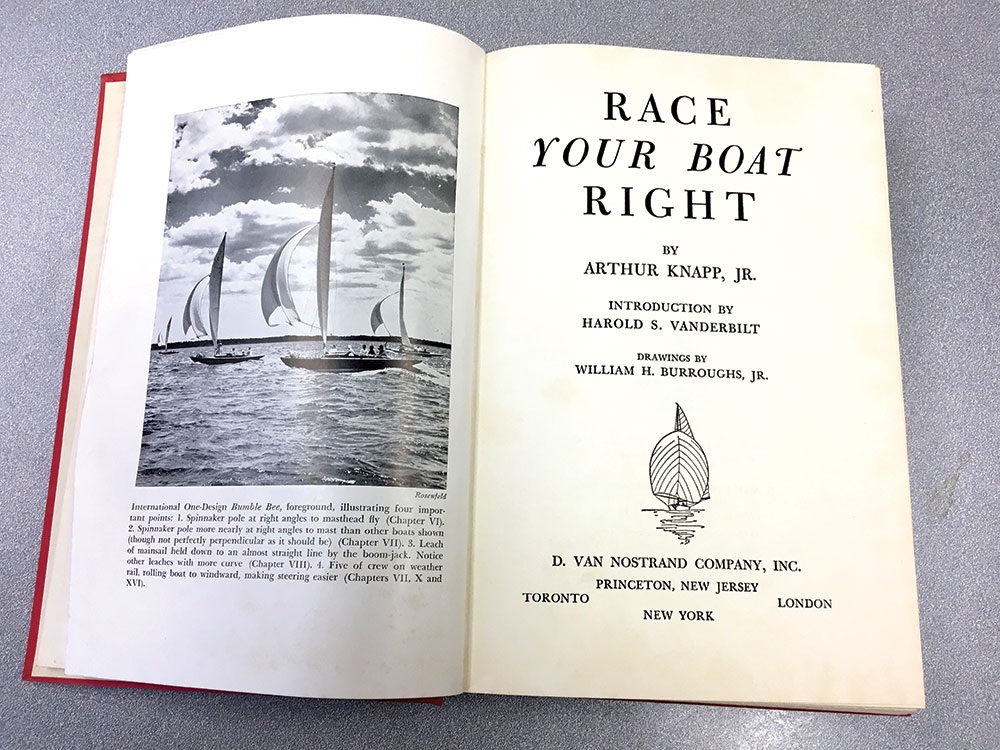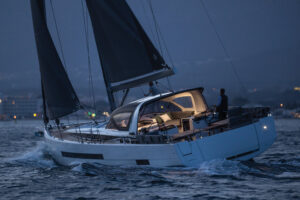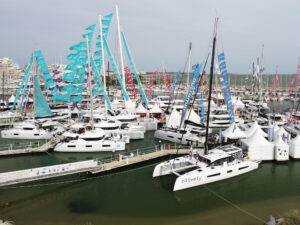
Some of my most treasured possessions are nautical books signed by the authors, which I’ve been collecting for years. Among many others, my bookshelf is graced by prized, inscribed copies of A World of My Own by Robin Knox-Johnston (with a joke about my sailing skills); Adrift by Steve Callahan (with a cool personalized sketch like the ones in the book); and Cruising in Seraffyn by Lin and Larry Pardey (with nice notes from both authors). But one of my favorite titles is Arthur Knapp’s Race Your Boat Right, a tome not familiar to many cruising sailors but a classic in its own right.
Knapp’s book was a gift from friends who, knowing my obsession, came across it while perusing the shelves of a used bookstore. Written in 1952, Knapp signed it for its original owner, a fellow named John J. Flynn (“one of the finest Irishmen I know!”). Despite my passion for such things, I’ve always wondered if my pals gave it to me thanks to Knapp’s signature or because they believed I could really use the advice imparted therein. Not really wanting to know the answer, I never posed the question.
In any event, Knapp was certainly qualified to pen such a book. A lifelong racing sailor, he twice was the world champion of the prestigious Star class. In 1928, as a member of the Princeton sailing team, he was victorious in the school’s first intercollegiate regatta, vanquishing both Yale and Harvard in the process. A decade later, he won the America’s Cup as crew and sail trimmer aboard the J boat Ranger, skippered by the legendary Harold “Mike” Vanderbilt, who later wrote the introduction to Race Your Boat Right.
Knapp’s book, which is astonishing in its attention to detail, is definitely the work of an entirely different era. There are long discussions about the merits and maintenance of cotton sails; confusion over the preference by sailmakers of Dacron over Orlon in the brilliant new “synthetic” sails; and wonder at the lack of indispensable “masthead flies,” a rarity then but now better known as the Windex found on practically every sailboat.
In about equal amounts of jaw-dropping bewilderment and humbling awe, Knapp’s observations are downright stunning. For example, his discussion of the red spinnakers employed on Carleton Mitchell’s Finisterre is amazing: The color supposedly picked up heat from the sun that developed an upward thermal draft that enabled the sail to lift higher and stay fuller for a longer amount of time (huh?).
But his local-knowledge description of sniffing out the wind on Long Island Sound is awesome: “When the haze back in the hills of Long Island gets heavier, making the treetops in the background appear a lighter shade of green, you can almost bet your bottom dollar that a new breeze — a sea breeze — is trying to break through from the ocean. The same thing follows when the tall buildings in New York, the Chrysler, Empire State and others, fade from sight. If these buildings have been clearly visible during the early afternoon and then suddenly fade out, your sou’wester is on its way and will hit in eventually.”
All that said, at least by the standards of contemporary mores, Knapp’s take on all sorts of matters can be the source of either unintentional comedy or cringe-worthy embarrassment. For example, in his discussion of deck layouts, Knapp notes, “Winches like wenches come in all shapes and sizes.”
And here’s one that slipped past the surgeon general: “Make sure you and/or your crew are abundantly supplied with smokes of one sort or another. While I intend to endorse no special brand of cigarette, I do heartily endorse the use of smokes of one kind or another as a means of determining the wind on a flat day. Time and again we have literally smoked our way past other boats, puffing and checking the wind for the least little cat’s paw. The masthead fly and telltales are wonderful when there is a breeze, but when it’s flat, Lady Nicotine will be more helpful.”
Cough. Gasp. OK.
Then there’s this beauty, about recruiting a favorite Italian sailor as a ringer on a raceboat: “You’d better pick the Guinea or that boat will never go!”
Knapp concludes his text by reminding us never to stop sailing your hardest until the very last moment when you cross the finish line: “Church ain’t out till the singin’.”
That’s probably a metaphor for life as well. All these years later, Arthur Knapp still hums a zany tune.








